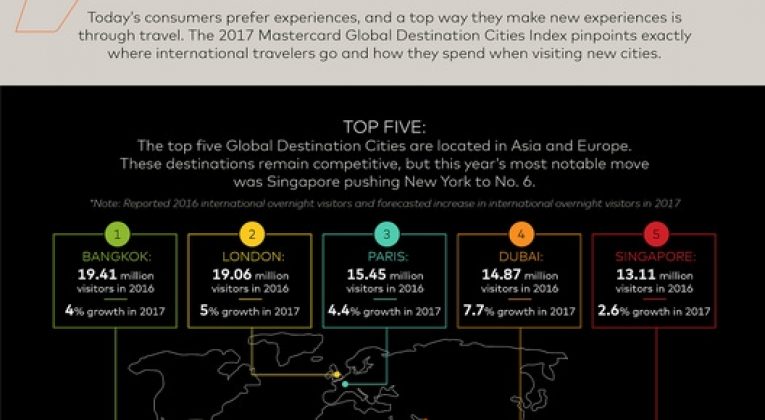How big a part does shopping play in your choice of cities to visit? If you’re like most travelers, the answer is “a big part.”
A new study by MasterCard reveals the top cities chosen by travelers for overnight stays, and sheds light on why travelers choose the cities they chose.
The MasterCard Global Destination Cities Index is based on “public data”—it isn’t limited to MasterCard customer transactions.
Top Destination Cities
The report ranks 132 cities by visitor volume and spend for 2016, and projects the expected growth in overnight visits for 2017. The top-10 cities by visitor volume:
- Bangkok: 19.4 million visitors; 4.0% projected growth for 2017
- London: 19.1 million visitors; 5.0% projected growth for 2017
- Paris: 15.5 million visitors; 4.4% projected growth for 2017
- Dubai: 14.9 million visitors; 7.7% projected growth for 2017
- Singapore: 13.1 million visitors; 2.6% projected growth for 2017
- New York: 12.7 million visitors; (2.2%) projected growth for 2017
- Seoul: 12.4 million visitors; 0.4% projected growth for 2017
- Kuala Lumpur: 11.3 million visitors; 7.2 projected growth for 2017
- Tokyo: 11.2 million visitors; 12.2% projected growth for 2017
- Istanbul: 9.2 million visitors; 0.9% projected growth for 2017
For spend, the top-10 list is both similar and different, with Istanbul and Kuala Lumpur replaced by Taipei and Barcelona:
- Dubai: $28.5 billion in overnight visitor spend; 10.2% projected growth for 2017
- New York: $17.0 billion in overnight visitor spend; 1.5% projected growth for 2017
- London: $16.1 billion in overnight visitor spend; (4.6%) projected growth for 2017
- Singapore: $15.7 billion in overnight visitor spend; 0.3% projected growth for 2017
- Bangkok: $14.1 billion in overnight visitor spend; 10.9% projected growth for 2017
- Paris: $12.0 billion in overnight visitor spend; 4.9% projected growth for 2017
- Tokyo: $11.3 billion in overnight visitor spend; 3.7% projected growth for 2017
- Taipei: $9.9 billion in overnight visitor spend; 6.9% projected growth for 2017
- Seoul: $9.4 billion in overnight visitor spend; 1.8% projected growth for 2017
- Barcelona: $8.9 billion in overnight visitor spend; 6.9% projected growth for 2017
Why We Travel, What We Spend
Among the top-10 cities, the great majority of travelers self-described the purpose of their visits as leisure rather than business. Bangkok visits, for example, were 88.6 percent leisure-focused, and 92.2 percent of Kuala Lumpur visits were for leisure.
Perhaps it’s no surprise, then, that shopping and dining account for a disproportionate share of visitors’ spend. For instance, 56.5 percent of travelers’ spending in Seoul was for shopping, 46.7 percent was for shopping in London, 43.4 percent in Osaka, and 43.1 percent in Tokyo. Whether or not travelers visited those and other cities with shopping uppermost in mind, shopping is what they did. And whereas spending on the other two dominant categories, dining and accommodations, isn’t optional—you have to eat and sleep—shopping is entirely discretionary.
Related:
The takeaway, then, based on travelers’ behavior in the world’s most-visited cities, is that travel and shopping are deeply linked. As someone who is more on the shopping-adverse end of the spectrum, I find that result somewhat surprising. It’s certainly not why I travel. But the data suggest, strongly, that I’m an outlier, a non-shopper among avid consumers.
So shop on, fellow travelers! While you might not see me at Harrods or Saks Fifth Avenue or the boutiques of Roppongi, there’s a good chance you’ll find me spending lavishly at one of the Michelin-starred eateries in those and other cities.
After 20 years working in the travel industry, and almost that long writing about it, Tim Winship knows a thing or two about travel. Follow him on Twitter @twinship.
This article first appeared on SmarterTravel.com, where Tim is Editor-at-Large.



